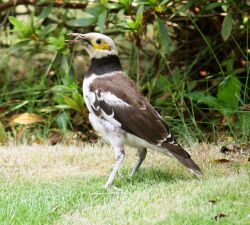Biology:Gracupica
| Gracupica | |
|---|---|

| |
| Black-collared starling (Gracupica nigricollis) | |
| Scientific classification | |
| Domain: | Eukaryota |
| Kingdom: | Animalia |
| Phylum: | Chordata |
| Class: | Aves |
| Order: | Passeriformes |
| Family: | Sturnidae |
| Genus: | Gracupica Lesson, 1831 |
| Type species | |
| Gracula melanoleuca[1] = Gracula nigricollis Lesson, 1831
| |
Gracupica is a genus of Asian birds in the family Sturnidae. It is sometimes merged with Sturnus or Sturnia.
Taxonomy
The genus Gracupica was introduced in 1831 by the French naturalist René Lesson to accommodate the black-collared starling which is therefore the type species.[2][3] The genus name combines the Latin graculus meaning "jackdaw" with pica meaning "magpie".[4]
Species
The genus contains four species.[5]
| Image | Scientific name | Common Name | Distribution |
|---|---|---|---|
 |
Gracupica nigricollis | Black-collared starling | Brunei, Cambodia, China, Laos, Myanmar, Thailand, and Vietnam |
 |
Gracupica contra | Indian pied myna | Indian subcontinent |

|
Gracupica floweri | Siamese pied myna | mainland Southeast Asia |

|
Gracupica jalla | Javan pied myna | southern Sumatra, Java, and Bali |
A 2021 study found that G. contra represents a species complex of 3 distinct species formerly thought to be subspecies of G. contra: the Indian pied myna (G. contra sensu stricto) from most of the Indian Subcontinent, Myanmar, and Yunnan in China ; the Siamese pied myna (G. floweri) from Thailand and Cambodia, and the possibly extinct in the wild Javan pied myna (G. jalla), historically known from Java and Bali in Indonesia.[6] The International Ornithological Congress has accepted these results.[7]
References
- ↑ "Sturnidae". The Trust for Avian Systematics. https://www.aviansystematics.org/4th-edition-checklist?viewfamilies=181.
- ↑ Lesson, René (1831) (in French). Traité d'Ornithologie, ou Tableau Méthodique. Paris: F.G. Levrault. p. 401 (livraison 6). https://www.biodiversitylibrary.org/page/35997385. Published in 8 livraisons between 1830 and 1831. For the publication date see: Dickinson, E.C.; Overstreet, L.K.; Dowsett, R.J.; Bruce, M.D. (2011). Priority! The Dating of Scientific Names in Ornithology: a Directory to the literature and its reviewers. Northampton, UK: Aves Press. p. 119. ISBN 978-0-9568611-1-5. https://www.researchgate.net/publication/267763194.
- ↑ Mayr, Ernst; Greenway, James C. Jr, eds (1962). Check-list of Birds of the World. 15. Cambridge, Massachusetts: Museum of Comparative Zoology. p. 104. https://www.biodiversitylibrary.org/page/14485477.
- ↑ Jobling, James A. (2010). The Helm Dictionary of Scientific Bird Names. London: Christopher Helm. p. 176. ISBN 978-1-4081-2501-4. https://archive.org/stream/Helm_Dictionary_of_Scientific_Bird_Names_by_James_A._Jobling#page/n176/mode/1up.
- ↑ Gill, Frank; Donsker, David; Rasmussen, Pamela, eds (July 2021). "Nuthatches, Wallcreeper, treecreepers, mockingbirds, starlings, oxpeckers". IOC World Bird List Version 11.2. International Ornithologists' Union. https://www.worldbirdnames.org/bow/nuthatch/.
- ↑ Baveja, Pratibha; Garg, Kritika M.; Chattopadhyay, Balaji; Sadanandan, Keren R.; Prawiradilaga, Dewi M.; Yuda, Pramana; Lee, Jessica G. H.; Rheindt, Frank E. (2021). "Using historical genome-wide DNA to unravel the confused taxonomy in a songbird lineage that is extinct in the wild" (in en). Evolutionary Applications 14 (3): 698–709. doi:10.1111/eva.13149. ISSN 1752-4571. PMID 33767745. Bibcode: 2021EvApp..14..698B.
- ↑ "Taxonomic Updates – IOC World Bird List" (in en-US). https://www.worldbirdnames.org/new/updates/taxonomy/.
External links
Wikidata ☰ Q3770027 entry
 |

